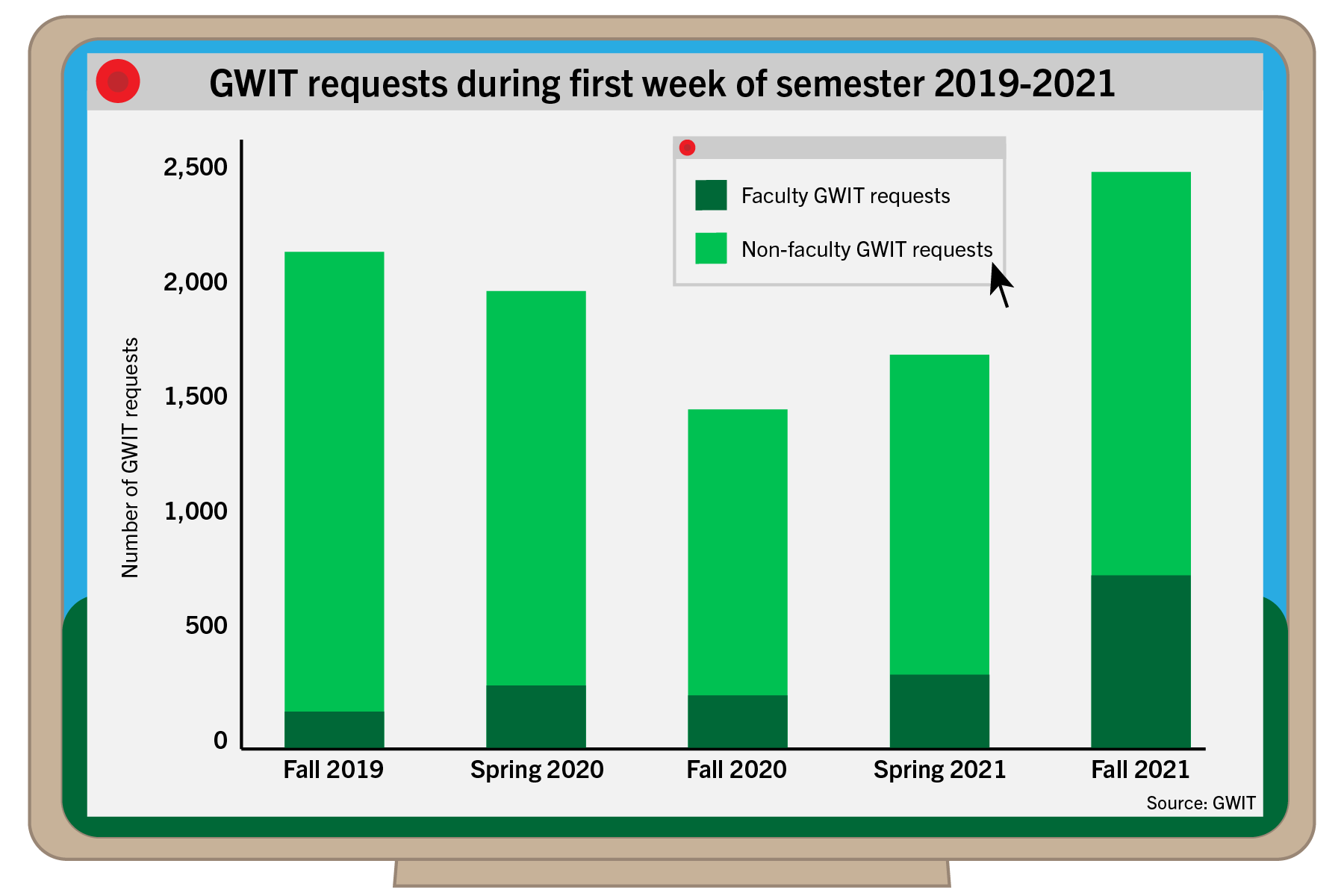GW Information Technology staff faced a surge in support requests during the first week of classes this fall as the office kicks off its first semester back on campus after dozens of IT staff were laid off amid the COVID-19 pandemic.
GWIT received 751 support requests from faculty during the first week of classes, more than double the 317 requests received during the first week of virtual classes in spring 2021, according to University data. Five professors said IT staff were not adequately equipped to handle support requests at the start of the semester, which they credit to the University’s switch to a shared services model for IT.
Officials consolidated GW’s technology departments into a centralized, shared services model last summer to reduce costs and mitigate the financial impact of the pandemic. Officials laid off dozens of technology staff and asked them to reapply for a smaller number of positions under the new structure.
Interim Chief Technology Officer Jared Johnson said the data on the number of IT support requests before this past spring does not include requests filed under the new shared services model, and faculty support requests before that semester were routed by individual school IT units.
“We are excited to welcome everyone back to campus, and after such a long absence, we are experiencing an increased number of IT support tickets,” Johnson said in an email. “We are flexing team members across the IT shared services unit to get issues triaged, identified and if needed, escalated to the proper teams to resolve customer issues as quickly as possible.”
Johnson said IT staff received 2,511 total support requests during the first week of the fall semester, an approximately 46 percent increase compared to the 1,714 requests during the first week of the spring semester, when officials implemented the shared-services model.

Nicholas Anastacio | Graphics Editor
Johnson said officials are prioritizing IT support requests from professors who call in from classroom phones needing assistance during class. He said “hundreds of more” professors are using class recording technology this year, and many faculty have been filing requests for “classroom technology” and computer and printer support.
Officials upgraded classroom technology for in-person instruction this fall with new computers, web cameras and microphones for faculty to record classes, on top of access to virtual platforms.
Faculty said the new shared services model is to blame for what they call “overworked” and overloaded IT employees.
Joe Cordes, a professor of economics and the co-chair of the Faculty Senate’s fiscal planning and budgeting committee, said former Provost Brian Blake, who implemented the IT shared services model, never offered “much, if any evidence” that the new model would maintain the same level of IT support while reducing costs. He said while officials were able to reduce costs, it may have led to longer IT support times.
“To be sure, less is being spent on IT support because of employee layoffs and consolidation, but the jury is still out whether IT support services are available at the same level than before,” he said in an email.
Cordes said under the previously decentralized IT system, faculty received new computers every three years, and staff would receive computers previously used by other faculty. He said under the shared services model, faculty and staff receive computers every four years, but some have described the change as “more costly than it needs to be” since older equipment for staff members would be “perfectly adequate” given the work they need to do.
“I personally support the idea of providing staff as well as faculty with up-to-date computing resources, and it may well be that this is best accomplished by centralization,” he said. “There was, however, little discussion with appropriate faculty about the academic implications of making the change – e.g. is faculty research and teaching hampered by replacing faculty computers every four years instead of three.”
Harald Griesshammer, an associate professor of physics and a faculty senator, said he has noticed that IT staff have been working “more than overtime” in recent weeks to address the surge in IT support requests. He said he’s not surprised that IT staff are overworked this semester given the restructuring and layoffs last summer.
“I’m frankly worried that they’re going to burn out and look for other jobs because how long can this go?” he said. “This is not something where we can wait for the next president to weigh in or wait till the middle of December. These are problems that need to be solved right now, today, and they need to be solved as hard cash on the table.”
Griesshammer said even if Chief Financial Officer Mark Diaz allocates money to hire more IT staff, filling positions and training new staff will take time.
“So we will have to live with understaffed IT, sponsored research, facilities etc. for the rest of this semester and possibly even into the next one full, all this assuming that the finance office does immediately recognize the need,” he said in an email.
David Rain, the chair of the geography department and an associate professor of geography and international affairs, said the geography department used the Office of Technology Services’ cloud drive for the Columbian College of Arts and Science to store large data sets used for research and class. He said since returning to in-person classes, some faculty in the department have struggled with slow download speeds for data sets, which has put a halt on their research and some classroom activities.
“I just want to have the regular service restored,” he said. “I’m the chair of geography – it affects all my faculty. I mean, regardless of whether they teach geospatial courses or not, it affects everyone because we’re all based around our shared drive.”
Michael Mann, an assistant professor of geography, said officials’ decision to consolidate OTS into the IT department last year was “short-sighted.” He said before the pandemic, OTS played a “critical” role in CCAS’ daily operations because it offered services like cloud storage and classroom technology assistance, and staff were quick to respond to faculty complaints.
“That memory, unfortunately, was erased after deep cuts and burnout took some of the most experienced staff,” Mann said in an email. “In the end, we were left going into the semester where newly arrived faculty had no computers, a cloud drive that held our lectures captive, missing software licenses, desktop computers without internet connections and a swamped IT department.”







